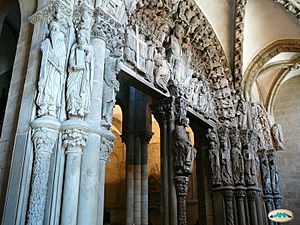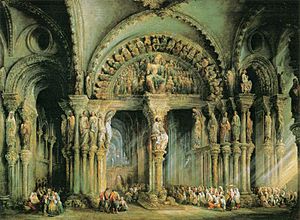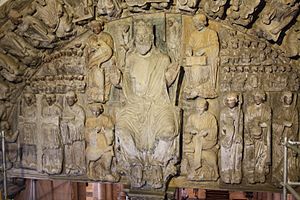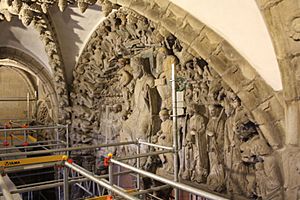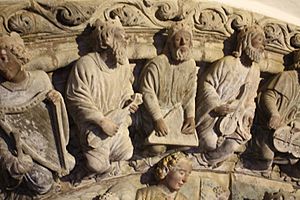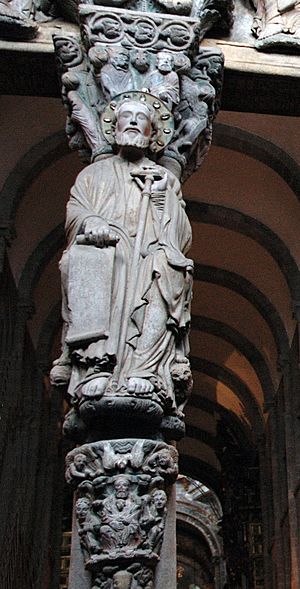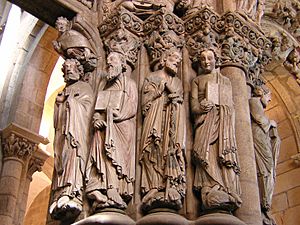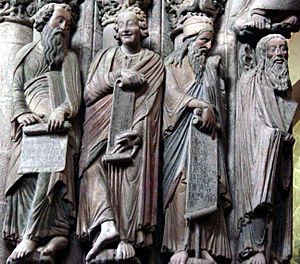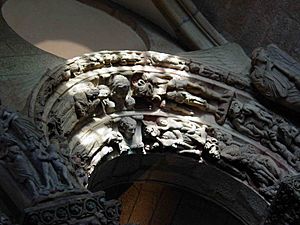Portico of Glory facts for kids
The Portico of Glory (which means Pórtico da Gloria in Galician) is a famous entrance at the Santiago de Compostela Cathedral in Spain. It's a masterpiece of Romanesque art. Master Mateo and his team created this amazing gate. King Ferdinand II of León ordered its creation. The king paid Mateo money every year from 1168 to 1188.
The Portico was finished in 1188. This date is carved on a stone in the cathedral. It is also on the lintel, which is the beam above the door. The whole project took until 1211 to complete. That's when the cathedral was officially opened.
This portico has over 200 Romanesque sculptures. Many people think it's the best Romanesque sculpture in Spain. It has an inner porch with two arches. It also has an outer western front. The sides of the arches were left plain. This might have been because they needed to finish it quickly. They wanted it ready for a special event in 1182.
The original Romanesque design changed a bit over time. Later, a Baroque style front was built around it. This new front hides the portico from the outside. Before this, you could see the portico from far away. Pilgrims would walk up many steps to reach it. The three large arches had no doors. They were decorated with angels and plants. Prophets and apostles carved into the columns welcomed pilgrims inside.
The portico was once painted with many colors. You can still see traces of paint today. Records show it was repainted often in the 1400s and 1600s. Some paint looks soft and light. This is from the 1400s or 1500s. Other paint is darker and shinier. This style is from the 1600s. The church still takes care of the portico today. In the Middle Ages, its doors were never closed.
Contents
What is the Architecture of the Portico of Glory?
Before starting the portico, Master Mateo's team finished the church's main hall, called the nave. They built a new crypt (an underground room) below the nave. The portico itself has an undercroft. This is a chapel called the catedral vieja (old cathedral). The portico is about 57 feet wide and 13.5 feet deep. It fits between the church's towers.
Because Mateo had limited space, he designed the portico to be very tall. He used many carved figures. There are three round arches. These arches match the three main parts of the church. Thick pillars with flat columns support them.
Master Mateo was inspired by local art. He also looked at French designs. The sculptures are unique to Mateo and his team. The church's archbishop and Mateo decided on the designs. The archbishop liked French art. This influenced the portico's style. For example, some figures are simple but expressive. The portico is thought to be Mateo's last major work.
The portico combines different building styles. It has features from Cistercian and early Gothic French buildings. Its large, ribbed ceiling is the first of its kind in Spain. The figures look very human. They show a mix of styles from old manuscripts and pilgrim art.
The portico tells a story using symbols. It connects the pilgrim's journey to the meaning of life. The central arch shows glory and resurrection. This is the goal for true Christians. The left arch shows Old Testament figures. They are waiting for Christ. The right arch shows the New Testament and the Last Judgment. Four angels blow trumpets in the corners. They represent the four corners of the world.
What is the Central Arch?
The middle arch is twice as wide as the other two. It has a large carved area called a tympanum. A central column, called a mullion, divides the arch. This column features a statue of Saint James.
The bottom of the column has fantastic animals. The middle part has columns with statues. These are Apostles on the right and Prophets on the left. The sculptures tell stories from the Book of Revelation and the Old Testament. The central arch shows the glory of Christ. It also shows how people can be saved.
Four beasts and 24 elders are shown with angels. This is a vision of the end of the world. This idea was first seen in a church near Paris. Below the figure of Christ, Master Mateo placed Saint James. Saint James is shown seated. He has a halo around his head. He holds a scroll in one hand and a staff in the other.
Central Tympanum: Christ and Angels
The tympanum's design comes from the Bible. It shows Christ in the center. He is very large, almost four yards tall. You can see the wounds from his crucifixion on his hands and feet.
Around Christ are the four Evangelists. They are shown with their special animals. Saint John has an eagle. Saint Luke has a lamb. Saint Mark has a lion. Saint Matthew writes on a scroll.
Eight angels stand at the bottom of the tympanum. Four on each side hold symbols of Christ's suffering. On the far left, a small figure kneels. Two angels stand next to Mark and Luke. They hold a cross. Another angel holds a crown of thorns.
On the right, four angels stand. One holds four nails and a spear. The next holds a jar of vinegar. It also holds the scroll where Pilate wrote Christ's sentence. The letters "I N R I" are on the scroll. Another angel holds the whip used for flogging. The last angel carries a rod with a sponge. Behind Christ's raised hands are two angels with censers.
The space around the tympanum has 38 small figures. These figures might be people from the Holy City. Or they could be the "ten thousand times ten thousand" who sing a new song. They are crowded together. Some are praying. Others hold scrolls or books. All their eyes look towards Jesus.
At the ends of the tympanum are archangels. They hold symbols of the Passion. These figures show human souls moving towards Christ. They represent people from different groups. On the outside of these angels are two more. The left angel leads two children. The right one leads three children and holds one. This shows a prophecy about many children.
Central Archivolt: Musicians and Elders
The central arch has three rows of carvings. They are decorated with many plants and flowers. Angels carry souls to Paradise. This symbolizes the Day of Judgment. It also shows praise for God.
Above the angels, there are two large groups of blessed souls. There are 40 in total. Around the inner part of the arch are the elders from the Apocalypse. Each elder holds a musical instrument. They look like they are getting ready for a concert for God. They wear crowns and some carry vessels.
The figures sit on a long bench. They talk to each other in pairs. The instruments include an organistrum, guitar, cittern, and harp. There are also wind instruments like the aulos. Eight violas are shown. Percussion instruments include bells, tambourines, and castanets. One instrument is an early vihuela, which is like an old guitar.
What is the Mullion?
The main doorway is very wide. A central column, called a mullion, supports the beam above it. This column has a large statue of Saint James. He is seated and holds a pilgrim's staff. Pilgrims often kneel and touch or kiss his feet. He holds a scroll that says "Misit me Dominus" (the Lord sent me). He has a halo with crystals, which was added later. Two lions support the legs of his chair.
The top of the column above his head shows Christ's temptations. On the side facing the church, two angels are kneeling and praying. At the saint's feet is another carved top. It shows the Holy Trinity. Below this is the tree of Jesse. This shows the family tree of Jesus Christ. It's the first time this symbol was used in religious art in Spain.
The column rests on a base. There is a bearded figure there, possibly Noah. He has his arms stretched over two lions with open mouths. The writing on this part is no longer clear.
At the bottom of the central column, facing the main altar, is a kneeling figure. It's a young man with curly hair. This figure represents Master Mateo himself. He holds a sign that says "Architectus" (architect). It also has the date the main entrance was finished. This statue is known as "Santo dos croques." People used to rub their heads against it for wisdom. Students and pilgrims still do this. But steps are being taken to stop it. This is to protect the old sculpture from damage.
What are the Jambs?
The columns of the central and side doors have figures. These are apostles, prophets, and other important people. They each have symbols that help identify them. All the figures have detailed carved tops above their heads. These carvings show animals and human heads with leaves.
Some figures have their names on the books or scrolls they hold. Scrolls usually mean the Old Testament. Closed books mean the Apostles or the New Testament.
The columns show lifelike figures. They are similar in size to Saint James on the central column. On the left side of the central arch, you can see Jeremiah, Daniel, Isaiah, and Moses. On the right side of the central arch are four Apostles: Saints Peter, Paul, James, and John the Evangelist. All these figures stand. They have realistic expressions. They look like wise people talking together.
The side arches also have figures on their pillars. There are four figures on each side. On the left side of the northern arch, you might see Amos and Moses. On the right, there might be Obadiah and Joel. On the left side of the southern arch are the apostles Philip and Andrew. On the right are Bartholomew and Thomas.
There are three more statues on each side of the outer doors. On the left, you can see Queen Esther, Judith, and Job or Tobias. On the right, there is St. John the Baptist, St. Luke, and St. Mark.
Only three columns, besides the central one, are carved. The columns to the left and right of the central one have spiral carvings. On the left, you can see Abraham sacrificing Isaac. On the right, there are counsels given to the church. The last carved column is to the right of the north arch. It shows a medieval tournament. This one might have replaced a plain column later. The columns are very tall and strong. They show the strength of the pillars.
What is the Left Door?
The arch of the left door is the northern entrance. It shows scenes from the Old Testament. There are upper and lower bands. They show good people waiting for the Savior. In the middle of the lower arch, God the Creator blesses pilgrims. He holds the Book of Eternal Truth. To his right are Adam, Abraham, and Jacob. With them are figures who might be Noah and Esau, or Isaac and Judah. To God's left are Eve, Moses, Aaron, King David, and Solomon.
Above this, the second arch has 12 small figures. They represent the twelve tribes of Israel. Angels lead figures to paradise. They are surrounded by plants. The figures hold scrolls with God's word. But they are bound by heavy carvings. These symbolize the Jewish Law that holds them.
What is the Right Door?
The arch of the right door is the southern entrance. It shows the Last Judgment. The double arch is split into two parts. Two heads are in the center. Some people think these heads are Archangel Michael and Christ. Others think they are Christ as Judge and an angel. Or they might be God the Father and God the Son.
To the right of these heads, Hell is shown. There are monster-like figures or demons. They drag and torture the souls of the damned. These demons represent bad things like violence, cruelty, and greed. On the left, Heaven is shown. It has angels with children. These children symbolize saved souls. Four angels blow trumpets for the Last Judgment. The other angels sing. The two busts of Christ show his presence. They mean mercy and salvation for everyone.
What are the Bases?
The four main pillars of the portico stand on strong bases. These bases are carved with groups of animals. There are six eagles, a bear, four lions, and two other animals. There are also three human heads with beards. These heads seem to hold up the entire portico on their backs.
These strange animal figures might be demons. They symbolize sin being crushed by glory. Other ideas suggest they represent war, hunger, and death. These are situations that only human intelligence can solve. This is shown by the heads of the old men.
See also
 In Spanish: Pórtico de la Gloria para niños
In Spanish: Pórtico de la Gloria para niños


